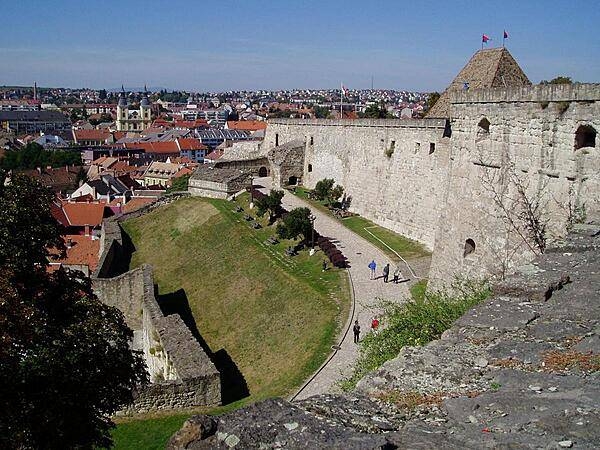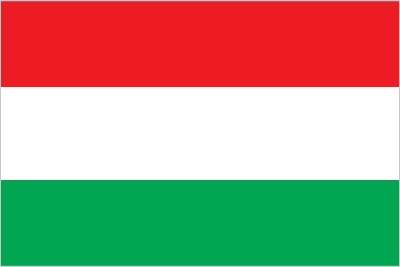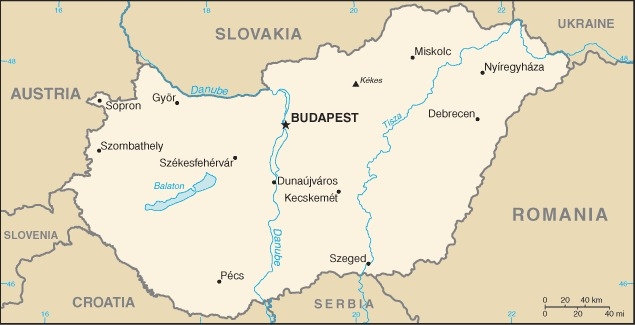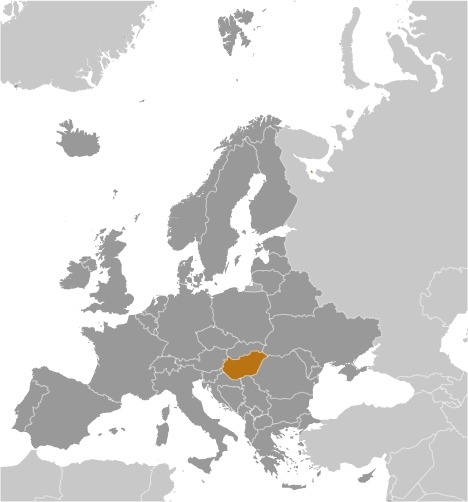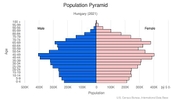Hungary
Introduction
Background
Hungary became a Christian kingdom in A.D. 1000 and for many centuries served as a bulwark against Ottoman Turkish expansion in Europe. The kingdom eventually became part of the polyglot Austro-Hungarian Empire, which collapsed during World War I. The country fell under communist rule following World War II. In 1956, a revolt and an announced withdrawal from the Warsaw Pact were met with a massive military intervention by Moscow. Under the leadership of Janos KADAR in 1968, Hungary began liberalizing its economy, introducing so-called "Goulash Communism." Hungary held its first multiparty elections in 1990 and initiated a free market economy. It joined NATO in 1999 and the EU five years later.
Visit the Definitions and Notes page to view a description of each topic.
Geography
Location
Central Europe, northwest of Romania
Geographic coordinates
47 00 N, 20 00 E
Map references
Europe
Land boundaries
total: 2,106 km
border countries (7): Austria 321 km, Croatia 348 km, Romania 424 km, Serbia 164 km, Slovakia 627 km, Slovenia 94 km, Ukraine 128 km
Coastline
0 km (landlocked)
Maritime claims
none (landlocked)
Climate
temperate; cold, cloudy, humid winters; warm summers
Terrain
mostly flat to rolling plains; hills and low mountains on the Slovakian border
Elevation
highest point: Kekes 1,014 m
lowest point: Tisza River 78 m
mean elevation: 143 m
Natural resources
bauxite, coal, natural gas, fertile soils, arable land
Land use
agricultural land: 58.9% (2018 est.)
arable land: 48.5% (2018 est.)
permanent crops: 2% (2018 est.)
permanent pasture: 8.4% (2018 est.)
forest: 22.5% (2018 est.)
other: 18.6% (2018 est.)
Irrigated land
1,721 sq km (2012)
Major watersheds (area sq km)
Atlantic Ocean drainage: (Black Sea) Danube (795,656 sq km)
Major lakes (area sq km)
Fresh water lake(s): Lake Balaton - 590 sq km
Major rivers (by length in km)
Danube (shared with Germany [s], Austria, Slovakia, Croatia, Serbia, Bulgaria, Ukraine, Moldova, and Romania [m]) - 2,888 km
note – [s] after country name indicates river source; [m] after country name indicates river mouth
Population distribution
a fairly even distribution throughout most of the country, with urban areas attracting larger and denser populations
Geography - note
landlocked; strategic location astride main land routes between Western Europe and Balkan Peninsula as well as between Ukraine and Mediterranean basin; the north-south flowing Duna (Danube) and Tisza Rivers divide the country into three large regions
People and Society
Nationality
noun: Hungarian(s)
adjective: Hungarian
Ethnic groups
Hungarian 85.6%, Romani 3.2%, German 1.9%, other 2.6%, unspecified 14.1% (2011 est.)
note: percentages add up to more than 100% because respondents were able to identify more than one ethnic group; Romani populations are usually underestimated in official statistics and may represent 5–10% of Hungary's population
Languages
Hungarian (official) 99.6%, English 16%, German 11.2%, Russian 1.6%, Romanian 1.3%, French 1.2%, other 4.2%; note - shares sum to more than 100% because some respondents gave more than one answer on the census; Hungarian is the mother tongue of 98.9% of Hungarian speakers (2011 est.)
major-language sample(s):
A World Factbook nélkülözhetetlen forrása az alapvető információnak. (Hungarian)
The World Factbook, the indispensable source for basic information.
Religions
Roman Catholic 37.2%, Calvinist 11.6%, Lutheran 2.2%, Greek Catholic 1.8%, other 1.9%, none 18.2%, no response 27.2% (2011 est.)
Age structure
0-14 years: 14.54% (male 731,542/female 689,739)
15-24 years: 10.43% (male 526,933/female 492,388)
25-54 years: 42.17% (male 2,075,763/female 2,044,664)
55-64 years: 12.17% (male 552,876/female 636,107)
65 years and over: 20.69% (male 773,157/female 1,248,658) (2020 est.)
Dependency ratios
total dependency ratio: 46.9
youth dependency ratio: 22
elderly dependency ratio: 30.8
potential support ratio: 3.2 (2020 est.)
Median age
total: 43.6 years
male: 41.5 years
female: 45.5 years (2020 est.)
Population distribution
a fairly even distribution throughout most of the country, with urban areas attracting larger and denser populations
Urbanization
urban population: 72.2% of total population (2021)
rate of urbanization: 0.05% annual rate of change (2020-25 est.)
Major urban areas - population
1.772 million BUDAPEST (capital) (2021)
Sex ratio
at birth: 1.06 male(s)/female
0-14 years: 1.06 male(s)/female
15-24 years: 1.07 male(s)/female
25-54 years: 1.02 male(s)/female
55-64 years: 0.87 male(s)/female
65 years and over: 0.62 male(s)/female
total population: 0.91 male(s)/female (2020 est.)
Mother's mean age at first birth
28.3 years (2019 est.)
Maternal mortality ratio
12 deaths/100,000 live births (2017 est.)
country comparison to the world: 139Infant mortality rate
total: 4.69 deaths/1,000 live births
male: 5.02 deaths/1,000 live births
female: 4.34 deaths/1,000 live births (2021 est.)
Life expectancy at birth
total population: 76.95 years
male: 73.27 years
female: 80.83 years (2021 est.)
Drinking water source
improved: urban: 100% of population
rural: 100% of population
total: 100% of population
unimproved: urban: 0% of population
rural: 0% of population
total: 0% of population (2017 est.)
Current Health Expenditure
6.7% (2018)
Physicians density
3.41 physicians/1,000 population (2018)
Hospital bed density
7 beds/1,000 population (2018)
Sanitation facility access
improved: urban: 100% of population
rural: 100% of population
total: 100% of population
unimproved: urban: 0% of population
rural: 0% of population
total: 0% of population (2017 est.)
HIV/AIDS - adult prevalence rate
<.1% (2018 est.)
HIV/AIDS - deaths
<100 (2018 est.)
Major infectious diseases
degree of risk: intermediate (2016)
vectorborne diseases: tickborne encephalitis (2016)
Literacy
definition: age 15 and over can read and write
total population: 99.1%
male: 99.1%
female: 99% (2015)
School life expectancy (primary to tertiary education)
total: 13 years
male: 12 years
female: 14 years (2019)
Unemployment, youth ages 15-24
total: 12.8%
male: 11.9%
female: 14% (2020 est.)
Environment
Environment - current issues
air and water pollution are some of Hungary's most serious environmental problems; water quality in the Hungarian part of the Danube has improved but is still plagued by pollutants from industry and large-scale agriculture; soil pollution
Environment - international agreements
party to: Air Pollution, Air Pollution-Heavy Metals, Air Pollution-Multi-effect Protocol, Air Pollution-Nitrogen Oxides, Air Pollution-Persistent Organic Pollutants, Air Pollution-Sulphur 85, Air Pollution-Sulphur 94, Air Pollution-Volatile Organic Compounds, Antarctic Treaty, Biodiversity, Climate Change, Climate Change-Kyoto Protocol, Climate Change-Paris Agreement, Comprehensive Nuclear Test Ban, Desertification, Endangered Species, Environmental Modification, Hazardous Wastes, Law of the Sea, Marine Dumping-London Convention, Nuclear Test Ban, Ozone Layer Protection, Ship Pollution, Tropical Timber 2006, Wetlands, Whaling
signed, but not ratified: Antarctic-Environmental Protection
Air pollutants
particulate matter emissions: 15.62 micrograms per cubic meter (2016 est.)
carbon dioxide emissions: 45.54 megatons (2016 est.)
methane emissions: 7.25 megatons (2020 est.)
Climate
temperate; cold, cloudy, humid winters; warm summers
Land use
agricultural land: 58.9% (2018 est.)
arable land: 48.5% (2018 est.)
permanent crops: 2% (2018 est.)
permanent pasture: 8.4% (2018 est.)
forest: 22.5% (2018 est.)
other: 18.6% (2018 est.)
Urbanization
urban population: 72.2% of total population (2021)
rate of urbanization: 0.05% annual rate of change (2020-25 est.)
Revenue from forest resources
forest revenues: 0.1% of GDP (2018 est.)
country comparison to the world: 112Major infectious diseases
degree of risk: intermediate (2016)
vectorborne diseases: tickborne encephalitis (2016)
Waste and recycling
municipal solid waste generated annually: 3.712 million tons (2015 est.)
municipal solid waste recycled annually: 962,893 tons (2015 est.)
percent of municipal solid waste recycled: 25.9% (2015 est.)
Major lakes (area sq km)
Fresh water lake(s): Lake Balaton - 590 sq km
Major rivers (by length in km)
Danube (shared with Germany [s], Austria, Slovakia, Croatia, Serbia, Bulgaria, Ukraine, Moldova, and Romania [m]) - 2,888 km
note – [s] after country name indicates river source; [m] after country name indicates river mouth
Major watersheds (area sq km)
Atlantic Ocean drainage: (Black Sea) Danube (795,656 sq km)
Total water withdrawal
municipal: 624.5 million cubic meters (2017 est.)
industrial: 3.358 billion cubic meters (2017 est.)
agricultural: 518.6 million cubic meters (2017 est.)
Total renewable water resources
104 billion cubic meters (2017 est.)
Government
Country name
conventional long form: none
conventional short form: Hungary
local long form: none
local short form: Magyarorszag
former: Kingdom of Hungary, Hungarian People's Republic, Hungarian Soviet Republic, Hungarian Republic
etymology: the Byzantine Greeks refered to the tribes that arrived on the steppes of Eastern Europe in the 9th century as the "Oungroi," a name that was later Latinized to "Ungri" and which became "Hungari"; the name originally meant an "[alliance of] ten tribes"; the Hungarian name "Magyarorszag" means "Country of the Magyars"; the term may derive from the most prominent of the Hungarian tribes, the Megyer
Government type
parliamentary republic
Capital
name: Budapest
geographic coordinates: 47 30 N, 19 05 E
time difference: UTC+1 (6 hours ahead of Washington, DC, during Standard Time)
daylight saving time: +1hr, begins last Sunday in March; ends last Sunday in October
etymology: the Hungarian capital city was formed in 1873 from the merger of three cities on opposite banks of the Danube: Buda and Obuda (Old Buda) on the western shore and Pest on the eastern; the origins of the original names are obscure, but according to the second century A.D. geographer, Ptolemy, the settlement that would become Pest was called "Pession" in ancient times; "Buda" may derive from either a Slavic or Turkic personal name
Administrative divisions
19 counties (megyek, singular - megye), 23 cities with county rights (megyei jogu varosok, singular - megyei jogu varos), and 1 capital city (fovaros)
counties: Bacs-Kiskun, Baranya, Bekes, Borsod-Abauj-Zemplen, Csongrad-Csanad, Fejer, Gyor-Moson-Sopron, Hajdu-Bihar, Heves, Jasz-Nagykun-Szolnok, Komarom-Esztergom, Nograd, Pest, Somogy, Szabolcs-Szatmar-Bereg, Tolna, Vas, Veszprem, Zala
cities with county rights: Bekescsaba, Debrecen, Dunaujvaros, Eger, Erd, Gyor, Hodmezovasarhely, Kaposvar, Kecskemet, Miskolc, Nagykanizsa, Nyiregyhaza, Pecs, Salgotarjan, Sopron, Szeged, Szekesfehervar, Szekszard, Szolnok, Szombathely, Tatabanya, Veszprem, Zalaegerszeg
capital city: Budapest
Independence
16 November 1918 (republic proclaimed); notable earlier dates: 25 December 1000 (crowning of King STEPHEN I, traditional founding date); 30 March 1867 (Austro-Hungarian dual monarchy established)
National holiday
Saint Stephen's Day, 20 August (1083); note - commemorates his canonization and the transfer of his remains to Buda (now Budapest) in 1083
Constitution
history: previous 1949 (heavily amended in 1989 following the collapse of communism); latest approved 18 April 2011, signed 25 April 2011, effective 1 January 2012
amendments: proposed by the president of the republic, by the government, by parliamentary committee, or by Parliament members; passage requires two-thirds majority vote of Parliament members and approval by the president; amended several times, last in 2018
Legal system
civil legal system influenced by the German model
International law organization participation
accepts compulsory ICJ jurisdiction with reservations; accepts ICC jurisdiction
Citizenship
citizenship by birth: no
citizenship by descent only: at least one parent must be a citizen of Hungary
dual citizenship recognized: yes
residency requirement for naturalization: 8 years
Suffrage
18 years of age, 16 if married and marriage is registered in Hungary; universal
Executive branch
chief of state: President Janos ADER (since 10 May 2012)
head of government: Prime Minister Viktor ORBAN (since 29 May 2010)
cabinet: Cabinet of Ministers proposed by the prime minister and appointed by the president
elections/appointments: president indirectly elected by the National Assembly with two-thirds majority vote in first round or simple majority vote in second round for a 5-year term (eligible for a second term); election last held on 13 March 2017 (next to be held spring 2022); prime minister elected by the National Assembly on the recommendation of the president; election last held on 10 May 2018 (next to be held in April or May 2022)
election results: Janos ADER (Fidesz) reelected president; National Assembly vote - 131 to 39; Viktor ORBAN (Fidesz) reelected prime minister; National Assembly vote - 134 to 28
Legislative branch
description: unicameral National Assembly or Orszaggyules (199 seats; 106 members directly elected in single-member constituencies by simple majority vote and 93 members directly elected in a single nationwide constituency by party-list proportional representation vote; members serve 4-year terms)
elections: last held on 8 April 2018 (next to be held in April 2022)
election results: percent of vote by party list - Fidesz-KDNP 49.3%, Jobbik 19.1%, MSZP-PM 11.9%, LMP 7.1%, DK 5.4%, Momentum Movement 3.1%, Together 0.7%, LdU 0.5%, other 2.9%; seats by party - Fidesz 117, Jobbik 26, KDNP 16, MSZP 15, DK 9, LMP 8, PM 5, Together 1, LdU 1, independent 1; composition (as of October 2021) - men 173, women 26, percent of women 13.1%
Judicial branch
highest courts: Curia or Supreme Judicial Court (consists of the president, vice president, department heads, and has a maximum of 113 judges, and is organized into civil, criminal, and administrative-labor departments; Constitutional Court (consists of 15 judges, including the court president and vice president)
judge selection and term of office: Curia president elected by the National Assembly on the recommendation of the president of the republic; other Curia judges appointed by the president upon the recommendation of the National Judicial Council, a separate 15-member administrative body; judge tenure based on interim evaluations until normal retirement at age 62; Constitutional Court judges, including the president of the court, elected by the National Assembly; court vice president elected by the court itself; members serve 12-year terms with mandatory retirement at age 62
subordinate courts: 5 regional courts of appeal; 19 regional or county courts (including Budapest Metropolitan Court); 20 administrative-labor courts; 111 district or local courts
Political parties and leaders
Christian Democratic People's Party or KDNP [Zsolt SEMJEN]
Democratic Coalition or DK [Ferenc GYURCSANY]
Dialogue for Hungary (Parbeszed) or PM [Gergely KARACSONY, Timea SZABO]
Fidesz-Hungarian Civic Alliance or Fidesz [Viktor ORBAN]
Hungarian Socialist Party or MSZP [Bertalan TOTH]
Momentum Movement (Momentum Mozgalom) [Andras FEKETE-GYOR]
Movement for a Better Hungary or Jobbik [Tamas SNEIDER]
National Self-Government of Germans in Hungary or LdU [Olivia SCHUBERT]
Politics Can Be Different or LMP [Marta DEMETER, Laszlo LORANT-KERESZTES]
Together (Egyutt)
International organization participation
Australia Group, BIS, CD, CE, CEI, CERN, EAPC, EBRD, ECB, EIB, ESA (cooperating state), EU, FAO, G-9, IAEA, IBRD, ICAO, ICC (national committees), ICCt, ICRM, IDA, IEA, IFAD, IFC, IFRCS, ILO, IMF, IMO, IMSO, Interpol, IOC, IOM, IPU, ISO, ITSO, ITU, ITUC (NGOs), MIGA, MINURSO, NATO, NEA, NSG, OAS (observer), OECD, OIF (observer), OPCW, OSCE, PCA, Schengen Convention, SELEC, UN, UNCTAD, UNESCO, UNFICYP, UNHCR, UNIDO, UNIFIL, UNWTO, UPU, WCO, WFTU (NGOs), WHO, WIPO, WMO, WTO, ZC
Diplomatic representation in the US
chief of mission: Ambassador Szabolcs Ferenc TAKACS (since 23 December 2020)
chancery: 3910 Shoemaker Street NW, Washington, DC 20008
telephone: [1] (202) 362-6730
FAX: [1] (202) 966-8135
email address and website:
info@mfa.gov.hu
https://washington.mfa.gov.hu/eng
consulate(s) general: Chicago, Los Angeles, New York
Diplomatic representation from the US
chief of mission: Ambassador (vacant); Charge d'Affaires Marc DILLARD (since 30 October 2020)
embassy: Szabadsag ter 12, H-1054 Budapest
mailing address: 5270 Budapest Place, US Department of State, Washington, DC 20521-5270
telephone: [36] (1) 475-4400
FAX: [36] (1) 475-4248
email address and website:
acs.budapest@state.gov
https://hu.usembassy.gov/
Flag description
three equal horizontal bands of red (top), white, and green; the flag dates to the national movement of the 18th and 19th centuries, and fuses the medieval colors of the Hungarian coat of arms with the revolutionary tricolor form of the French flag; folklore attributes virtues to the colors: red for strength, white for faithfulness, and green for hope; alternatively, the red is seen as being for the blood spilled in defense of the land, white for freedom, and green for the pasturelands that make up so much of the country
National symbol(s)
Holy Crown of Hungary (Crown of Saint Stephen); national colors: red, white, green
Economy
Economic overview
Hungary has transitioned from a centrally planned to a market-driven economy with a per capita income approximately two thirds of the EU-28 average; however, in recent years the government has become more involved in managing the economy. Budapest has implemented unorthodox economic policies to boost household consumption and has relied on EU-funded development projects to generate growth.
Following the fall of communism in 1990, Hungary experienced a drop-off in exports and financial assistance from the former Soviet Union. Hungary embarked on a series of economic reforms, including privatization of state-owned enterprises and reduction of social spending programs, to shift from a centrally planned to a market-driven economy, and to reorient its economy towards trade with the West. These efforts helped to spur growth, attract investment, and reduce Hungary’s debt burden and fiscal deficits. Despite these reforms, living conditions for the average Hungarian initially deteriorated as inflation increased and unemployment reached double digits. Conditions slowly improved over the 1990s as the reforms came to fruition and export growth accelerated. Economic policies instituted during that decade helped position Hungary to join the European Union in 2004. Hungary has not yet joined the euro-zone. Hungary suffered a historic economic contraction as a result of the global economic slowdown in 2008-09 as export demand and domestic consumption dropped, prompting it to take an IMF-EU financial assistance package.
Since 2010, the government has backpedaled on many economic reforms and taken a more populist approach towards economic management. The government has favored national industries and government-linked businesses through legislation, regulation, and public procurements. In 2011 and 2014, Hungary nationalized private pension funds, which squeezed financial service providers out of the system, but also helped Hungary curb its public debt and lower its budget deficit to below 3% of GDP, as subsequent pension contributions have been channeled into the state-managed pension fund. Hungary’s public debt (at 74.5% of GDP) is still high compared to EU peers in Central Europe. Real GDP growth has been robust in the past few years due to increased EU funding, higher EU demand for Hungarian exports, and a rebound in domestic household consumption. To further boost household consumption ahead of the 2018 election, the government embarked on a six-year phased increase to minimum wages and public sector salaries, decreased taxes on foodstuffs and services, cut the personal income tax from 16% to 15%, and implemented a uniform 9% business tax for small and medium-sized enterprises and large companies. Real GDP growth slowed in 2016 due to a cyclical decrease in EU funding, but increased to 3.8% in 2017 as the government pre-financed EU funded projects ahead of the 2018 election.
Systemic economic challenges include pervasive corruption, labor shortages driven by demographic declines and migration, widespread poverty in rural areas, vulnerabilities to changes in demand for exports, and a heavy reliance on Russian energy imports.
Real GDP (purchasing power parity)
$302.32 billion note: data are in 2017 dollars (2020 est.)
$318.09 billion note: data are in 2017 dollars (2019 est.)
$303.98 billion note: data are in 2017 dollars (2018 est.)
note: data are in 2010 dollars
Real GDP growth rate
4.58% (2019 est.)
5.44% (2018 est.)
4.45% (2017 est.)
Real GDP per capita
$31,000 note: data are in 2017 dollars (2020 est.)
$32,600 note: data are in 2017 dollars (2019 est.)
$31,100 note: data are in 2017 dollars (2018 est.)
note: data are in 2010 dollars
GDP (official exchange rate)
$163.251 billion (2019 est.)
Inflation rate (consumer prices)
3.3% (2019 est.)
2.8% (2018 est.)
2.3% (2017 est.)
Credit ratings
Fitch rating: BBB (2019)
Moody's rating: Baa3 (2016)
Standard & Poors rating: BBB (2019)
GDP - composition, by sector of origin
agriculture: 3.9% (2017 est.)
industry: 31.3% (2017 est.)
services: 64.8% (2017 est.)
GDP - composition, by end use
household consumption: 49.6% (2017 est.)
government consumption: 20% (2017 est.)
investment in fixed capital: 21.6% (2017 est.)
investment in inventories: 1% (2017 est.)
exports of goods and services: 90.2% (2017 est.)
imports of goods and services: -82.4% (2017 est.)
Agricultural products
maize, wheat, milk, sunflower seed, barley, rapeseed, sugar beet, apples, pork, grapes
Industries
mining, metallurgy, construction materials, processed foods, textiles, chemicals (especially pharmaceuticals), motor vehicles
Labor force - by occupation
agriculture: 4.9%
industry: 30.3%
services: 64.5% (2015 est.)
Population below poverty line
12.3% (2018 est.)
Gini Index coefficient - distribution of family income
30.6 (2017 est.)
28.6 (2014)
Household income or consumption by percentage share
lowest 10%: 3.3%
highest 10%: 22.4% (2015)
Budget
revenues: 61.98 billion (2017 est.)
expenditures: 64.7 billion (2017 est.)
Budget surplus (+) or deficit (-)
-2% (of GDP) (2017 est.)
note: Hungary has been under the EU Excessive Deficit Procedure since it joined the EU in 2004; in March 2012, the EU elevated its Excessive Deficit Procedure against Hungary and proposed freezing 30% of the country's Cohesion Funds because 2011 deficit reductions were not achieved in a sustainable manner; in June 2012, the EU lifted the freeze, recognizing that steps had been taken to reduce the deficit; the Hungarian deficit increased above 3% both in 2013 and in 2014 due to sluggish growth and the government's fiscal tightening
Public debt
73.6% of GDP (2017 est.)
76% of GDP (2016 est.)
note: general government gross debt is defined in the Maastricht Treaty as consolidated general government gross debt at nominal value, outstanding at the end of the year in the following categories of government liabilities: currency and deposits, securities other than shares excluding financial derivatives, and national, state, and local government and social security funds.
Fiscal year
calendar year
Current account balance
-$392 million (2019 est.)
$510 million (2018 est.)
Exports
$123.83 billion note: data are in current year dollars (2020 est.)
$134.55 billion note: data are in current year dollars (2019 est.)
$134.66 billion note: data are in current year dollars (2018 est.)
Exports - partners
Germany 27%, Romania 5%, Italy 5%, Slovakia 5% (2019)
Exports - commodities
cars and vehicle parts, packaged medicines, spark-ignition engines, video displays, broadcasting equipment (2019)
Imports
$120.25 billion note: data are in current year dollars (2020 est.)
$129.9 billion note: data are in current year dollars (2019 est.)
$127.52 billion note: data are in current year dollars (2018 est.)
Imports - partners
Germany 25%, China 6%, Poland 6%, Austria 6%, Czechia 5%, Slovakia 5%, Italy 5%, Netherlands 5% (2019)
Imports - commodities
cars and vehicle parts, integrated circuits, packaged medicines, broadcasting equipment, crude petroleum (2019)
Reserves of foreign exchange and gold
$28 billion (31 December 2017 est.)
$25.82 billion (31 December 2016 est.)
Debt - external
$123.256 billion (2019 est.)
$125.29 billion (2018 est.)
Exchange rates
forints (HUF) per US dollar -
295.3276 (2020 est.)
299.4939 (2019 est.)
283.5923 (2018 est.)
279.33 (2014 est.)
232.6 (2013 est.)
Unemployment, youth ages 15-24
total: 12.8%
male: 11.9%
female: 14% (2020 est.)
Energy
Electricity access
electrification - total population: 100% (2020)
Electricity - installed generating capacity
8.639 million kW (2016 est.)
country comparison to the world: 67Electricity - from fossil fuels
64% of total installed capacity (2016 est.)
country comparison to the world: 122Electricity - from nuclear fuels
22% of total installed capacity (2017 est.)
country comparison to the world: 5Electricity - from hydroelectric plants
1% of total installed capacity (2017 est.)
country comparison to the world: 148Electricity - from other renewable sources
13% of total installed capacity (2017 est.)
country comparison to the world: 66Refined petroleum products - production
152,400 bbl/day (2017 est.)
country comparison to the world: 59Refined petroleum products - consumption
167,700 bbl/day (2017 est.)
country comparison to the world: 62Natural gas - proved reserves
6.598 billion cu m (1 January 2018 est.)
country comparison to the world: 83Communications
Telephones - fixed lines
total subscriptions: 2,970,347 (2020)
subscriptions per 100 inhabitants: 30.75 (2020 est.)
Telephones - mobile cellular
total subscriptions: 10,332,660 (2020)
subscriptions per 100 inhabitants: 107 (2020 est.)
Telecommunication systems
general assessment: Hungary benefits from a well-developed telecom infrastructure, with adoption of 5G and upgrade of fixed networks to 1Gb/s service; fixed-line subscribership fell as subscribers migrated to mobile for voice and data; effective infrastructure-based competition, with an extensive cable network competing against DSL and expanding fiber sector; high mobile penetration and highest fixed broadband penetration rate in Eastern Europe; government supports private partnership in smart agriculture applications; as part of EU, fully liberalized and open to investment; broadcasting equipment is one of the country’s top five imports, plus mobile phones, from China (2020)
domestic: competition among mobile-cellular service providers has led to a sharp increase in the use of mobile-cellular phones, and a decrease in the number of fixed-line connections, 31 per 100 persons, while mobile-cellular is 106 per 100 (2019)
international: country code - 36; Hungary has fiber-optic cable connections with all neighboring countries; the international switch is in Budapest; satellite earth stations - 2 Intelsat (Atlantic Ocean and Indian Ocean regions), 1 Inmarsat, 1 (very small aperture terminal) VSAT system of ground terminals
note: the COVID-19 pandemic continues to have a significant impact on production and supply chains globally; since 2020, some aspects of the telecom sector have experienced downturn, particularly in mobile device production; many network operators delayed upgrades to infrastructure; progress towards 5G implementation was postponed or slowed in some countries; consumer spending on telecom services and devices was affected by large-scale job losses and the consequent restriction on disposable incomes; the crucial nature of telecom services as a tool for work and school from home became evident, and received some support from governments
Broadcast media
mixed system of state-supported public service broadcast media and private broadcasters; the 5 publicly owned TV channels and the 2 main privately owned TV stations are the major national broadcasters; a large number of special interest channels; highly developed market for satellite and cable TV services with about two-thirds of viewers utilizing their services; 4 state-supported public-service radio networks; a large number of local stations including commercial, public service, nonprofit, and community radio stations; digital transition completed at the end of 2013; government-linked businesses have greatly consolidated ownership in broadcast and print media
Internet users
total: 8.01 million (2021 est.)
percent of population: 84.77% (2020 est.)
Broadband - fixed subscriptions
total: 3,265,308 (2020)
subscriptions per 100 inhabitants: 33.8 (2020 est.)
Transportation
National air transport system
number of registered air carriers: 5 (2020)
inventory of registered aircraft operated by air carriers: 145
annual passenger traffic on registered air carriers: 31,226,848 (2018)
Airports - with paved runways
total: 20
over 3,047 m: 2
2,438 to 3,047 m: 6
1,524 to 2,437 m: 6
914 to 1,523 m: 5
under 914 m: 1 (2017)
Airports - with unpaved runways
total: 21
1,524 to 2,437 m: 2
914 to 1,523 m: 8
under 914 m: 11 (2013)
Heliports
3 (2013)
Pipelines
5874 km gas (high-pressure transmission system), 83732 km gas (low-pressure distribution network), 850 km oil, 1200 km refined products (2016)
Railways
total: 8,049 km (2014)
standard gauge: 7,794 km 1.435-m gauge (2,889 km electrified) (2014)
narrow gauge: 219 km 0.760-m gauge (2014)
broad gauge: 36 km 1.524-m gauge (2014)
Roadways
total: 203,601 km (2014)
paved: 77,087 km (includes 1,582 km of expressways) (2014)
unpaved: 126,514 km (2014)
Ports and terminals
river port(s): Baja, Csepel (Budapest), Dunaujvaros, Gyor-Gonyu, Mohacs (Danube)
Military and Security
Military and security forces
the Hungarian Defense Forces are a unified force (Joint Force Command) with Land Forces, Air Forces, and Logistics components (2021)
Military expenditures
1.85% of GDP (2020 est.)
1.25% of GDP (2019)
1.01% of GDP (2018)
1.19% of GDP (2017)
1% of GDP (2016)
Military and security service personnel strengths
the Hungarian Defense Forces have approximately 23,000 active duty troops (18,000 Army; 5,000 Air Force) (2021)
note - in 2017, Hungary announced plans to increase the number of active soldiers to around 37,000, but did not give a timeline
Military equipment inventories and acquisitions
the inventory of the Hungarian Defense Forces consists largely of Soviet-era weapons, with a smaller mix of more modern European and US equipment; since 2010, Hungary has received limited quantities of equipment from several European countries and the US (2021)
Military deployments
160 Bosnia-Herzegovina (EUFOR stabilization force); 150 Iraq (counter-ISIS coalition); 430 Kosovo (NATO/KFOR) (2021)
Military service age and obligation
18-25 years of age for voluntary military service; no conscription (abolished 2005); 6-month service obligation (2021)
Military - note
Hungary joined NATO in 1999; Czechia, Hungary, and Poland were invited to begin accession talks at NATO's Madrid Summit in 1997 and in March 1999 they became the first former members of the Warsaw Pact to join the Alliance
Transnational Issues
Disputes - international
bilateral government, legal, technical and economic working group negotiations continue in 2006 with Slovakia over Hungary's failure to complete its portion of the Gabcikovo-Nagymaros hydroelectric dam project along the Danube; as a member state that forms part of the EU's external border, Hungary has implemented the strict Schengen border rules
Refugees and internally displaced persons
refugees (country of origin): 5,950 applicants for forms of legal stay other than asylum (Ukraine) (2015)
stateless persons: 145 (2020)
note: 432,744 estimated refugee and migrant arrivals (January 2015-December 2018); Hungary is predominantly a transit country and hosts 137 migrants and asylum seekers as of the end of June 2018; 1,626 migrant arrivals in 2017
Illicit drugs
transshipment point for Southwest Asian heroin and cannabis and for South American cocaine destined for Western Europe; limited producer of precursor chemicals, particularly for amphetamine and methamphetamine; efforts to counter money laundering, related to organized crime and drug trafficking are improving but remain vulnerable; significant consumer of ecstasy
